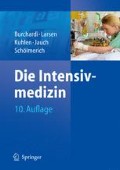Auszug
Eine akute Einschränkung der Nierenfunktion bis hin zum dialysepflichtigen Nierenversagen ist eine sehr häufige Komplikation bei Intensivpatienten. Obwohl das akute Nierenversagen (ANV), verglichen mit anderen Organversagen, technisch relativ einfach zu überbrücken ist, liegt die Mortalität von Patienten mit ANV bei etwa 50% und hat sich seit Einführung der Nierenersatztherapie nicht wesentlich verbessert. Diese ungünstige Prognose beruht zu einem großen Teil darauf, dass das Auftreten eines ANV Ausdruck des Schwergrades der Grunderkrankung und der Multimorbidität von Intensivpatienten ist (Patienten sterben »mit«, aber nicht »am« ANV).
Access this chapter
Tax calculation will be finalised at checkout
Purchases are for personal use only
Preview
Unable to display preview. Download preview PDF.
Literatur
Literatur zu Kap. 60.1-60.9
Loef BG, Epema AH, Smilde TD et al. (2005) Immediate postoperative renal function deterioration in cardiac surgical patients predicts in-hospital mortality and long-term survival. J Am Soc Nephrol 16: 195–200
Hoste EA, Clermont G, Kersten A et al. (2006) RIFLE criteria for acute kidney injury are associated with hospital mortality in critically ill patients: a cohort analysis. Crit Care 10: R73
Schrier RW, Wang W, Poole B et al. (2004) Acute renal failure: definitions, diagnosis, pathogenesis, and therapy. J Clin Invest 114:5–14
Levey AS, Bosch JP, Lewis JB et al. (1999) A more accurate method to estimate glomerular filtration rate from serum creatinine: a new prediction equation. Modification of Diet in Renal Disease Study Group. Ann Intern Med 130:461–470
Aronoff GR (2005) Dose adjustment in renal impairment: response from Drug Prescribing in Renal Failure. BMJ 331:293–294
Kellum JA, J MD (2001) Use of dopamine in acute renal failure: a meta-analysis. Crit Care Med 29:1526–1531
Bourgoin A, Leone M, Delmas A et al. (2005) Increasing mean arterial pressure in patients with septic shock: effects on oxygen variables and renal function. Crit Care Med 33:780–786
Sward K, Valsson F, Odencrants P et al. (2004) Recombinant human atrial natriuretic peptide in ischemic acute renal failure: a randomized placebo-controlled trial. Crit Care Med 32:1310–1315
Ho KM, Sheridan DJ (2006) Meta-analysis of frusemide to prevent or treat acute renal failure. BMJ 333:420
Morgera S, Kraft AK, Siebert G et al. (2002) Long-term outcomes in acute renal failure patients treated with continuous renal replacement therapies. Am J Kidney Dis 40:275–279
Literatur zu Kap. 60.10-60.17
Liu KD, Himmelfarb J, Paganini E et al. (2007) Timing of initiation of dialysis in criically ill patients with aute kidney injury. cJASN 1:915–919
Morgera S, Haase M, Rocktaschel J et al. (2003) High permeability haemofiltration improves peripheral blood mononuclearcell proliferation in septic patients with acute renal failure. Nephrol Dial Transplant 18:2570–2576
Weijmer MC, Vervloet MG, ter Wee PM (2004) Compared to tunnelled cuffed haemodialysis catheters, temporary untunnelled catheters are associated with more complications already within 2 weeks of use. Nephrol Dial Transplant 19:670–677
Pronovost P, Needham D, Berenholtz S et al. (2006) An intervention to decrease catheter-related bloodstream infections in the ICU. N Engl J Med 355:2725–2732
Weijmer MC, van den Dorpel MA, Van de Ven PJ et al. (2005) Randomized, clinical trial comparison of trisodium citrate 30% and heparin as catheter-locking solution in hemodialysis patients. J Am Soc Nephrol 16:2769–2777
Vinsonneau C, Camus C, Combes A et al. (2006) Continuous venovenous haemodiafiltration versus intermittent haemodialysis for acute renal failure in patients with multiple-organ dysfunction syndrome: a multicentre randomised trial. Lancet 368:379–385
Morgera S, Scholle C, Melzer C et al. (2004) A simple, safe and effective citrate anticoagulation protocol for the genius dialysis system in acute renal failure. Nephron Clin Pract 98: c35–40
Author information
Authors and Affiliations
Editor information
Editors and Affiliations
Rights and permissions
Copyright information
© 2008 Springer Medizin Verlag Heidelberg
About this chapter
Cite this chapter
Schindler, R., Eckardt, KU., Frei, U. (2008). Akutes Nierenversagen und extrakorporale Eliminationsverfahren. In: Burchardi, H., Larsen, R., Kuhlen, R., Jauch, KW., Schölmerich, J. (eds) Die Intensivmedizin. Springer, Berlin, Heidelberg. https://doi.org/10.1007/978-3-540-72296-0_60
Download citation
DOI: https://doi.org/10.1007/978-3-540-72296-0_60
Publisher Name: Springer, Berlin, Heidelberg
Print ISBN: 978-3-540-72295-3
Online ISBN: 978-3-540-72296-0
eBook Packages: Medicine (German Language)

